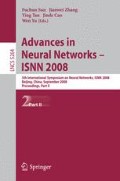Abstract
An associative memory is a particular type of neural network for recalling output patterns from input patterns that might be altered by noise. During the last 50 years, several associative models have emerged and they only have been applied to solve problems where input patterns are images. Most of these models have several constraints that limit their applicability in complex problems. Recently in [13] it was introduced a new associative model based on some aspects of the human brain. This model is robust under different type of noises and image transformations, and useful in complex problems such as face and 3d object recognition. In this paper we adopt this model and apply it to problems that not involve images patterns, we applied to speech recognition problems. In this paper it is described a novel application where an associative memory works as a voice translator device performing a speech recognition process. In order to achieve this, the associative memory is trained using a corpus of 40 English words with their corresponding translation to Spanish. Each association used during training phase is composed by a voice signal in English and a voice signal in Spanish. Once trained our English-Spanish translator, when a voice signal in English is used to stimulate the associative memory we expect that the memory recalls the corresponding voice signal in Spanish. In order to test the accuracy of the proposal, a benchmark of 14500 altered versions of the original voice signals were used.
Access this chapter
Tax calculation will be finalised at checkout
Purchases are for personal use only
Preview
Unable to display preview. Download preview PDF.
References
Steinbuch, K.: Die Lernmatrix. Kybernetik 1, 26–45 (1961)
Anderson, J.A.: A simple neural network generating an interactive memory. Math. Biosci. 14, 197–220 (1972)
Kohonen, T.: Correlation matrix memories. IEEE Trans. on Comp. 21, 353–359 (1972)
Hopfield, J.J.: Neural networks and physical systems with emergent collective computational abilities. Proc. Natl. Acad. Sci. 79, 2554–2558 (1982)
Sussner, P.: Generalizing operations of binary auto-associative morphological memories using fuzzy set theory. J. Math. Imaging Vis. 19, 81–93 (2003)
Ritter, G.X., et al.: Reconstruction of patterns from noisy inputs using morphological associative memories. J. Math. Imaging Vis. 19, 95–111 (2003)
Sossa, H., Barron, R., Vazquez, R.A.: Transforming Fundamental set of Patterns to a Canonical Form to Improve Pattern Recall. In: Lemaître, C., Reyes, C.A., González, J.A. (eds.) IBERAMIA 2004. LNCS (LNAI), vol. 3315, pp. 687–696. Springer, Heidelberg (2004)
Ritter, G.X., Sussner, P., Diaz de Leon, J.L.: Morphological associative memories. IEEE Trans. Neural Networks 9, 281–293 (1998)
Sussner, P., Valle, M.: Gray-Scale Morphological Associative Memories. IEEE Trans. on Neural Netw. 17, 559–570 (2006)
James, W.: Principles of Psychology, Holt, New York (1980)
Vazquez, R.A., Sossa, H., Garro, B.A.: 3D Object recognition based on low frequencies response and random feature selections. In: Gelbukh, A., Kuri, A.F. (eds.) MICAI 2007. LNCS (LNAI), vol. 4827, pp. 694–704. Springer, Heidelberg (2007)
Vazquez, R.A., Sossa, H., Garro, B.A.: Low frequency responses and random feature selection applied to face recognition. In: Kamel, M., Campilho, A. (eds.) ICIAR 2007. LNCS, vol. 4633, pp. 818–830. Springer, Heidelberg (2007)
Vazquez, R.A., Sossa, H.: A new associative memory with dynamical synapses (submitted to Neural Processing Letters, 2007)
Author information
Authors and Affiliations
Editor information
Editors and Affiliations
Rights and permissions
Copyright information
© 2008 Springer-Verlag Berlin Heidelberg
About this paper
Cite this paper
Vázquez, R.A., Sossa, H. (2008). Voice Translator Based on Associative Memories. In: Sun, F., Zhang, J., Tan, Y., Cao, J., Yu, W. (eds) Advances in Neural Networks - ISNN 2008. ISNN 2008. Lecture Notes in Computer Science, vol 5264. Springer, Berlin, Heidelberg. https://doi.org/10.1007/978-3-540-87734-9_39
Download citation
DOI: https://doi.org/10.1007/978-3-540-87734-9_39
Publisher Name: Springer, Berlin, Heidelberg
Print ISBN: 978-3-540-87733-2
Online ISBN: 978-3-540-87734-9
eBook Packages: Computer ScienceComputer Science (R0)

